Emerging trends shaping omnichannel customer experience
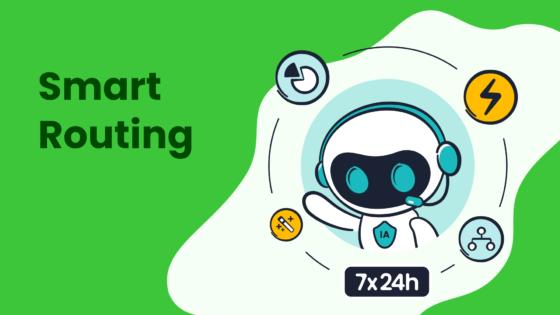
In 2025, delivering a flawless omnichannel customer experience has become vital for businesses aiming to thrive. Customers today expect seamless experiences across every touchpoint. Ignoring this can lead to significant losses. For instance, 61% of customers would switch to a competitor after a single bad experience. Additionally, 48% have already considered changing brands for better service. These numbers reveal how important it is to meet customer expectations consistently.
Emerging trends like advanced AI, hyper-personalization, and immersive technologies are transforming how businesses interact with you. Companies like Sobot are leading the way, offering innovative solutions to unify channels and improve service quality. Understanding what is omnichannel customer experience and how it shapes your interactions is crucial for staying ahead.
What is omnichannel customer experience and why it matters in 2025
Definition and key components of omnichannel experiences
Omnichannel customer experience refers to the ability of businesses to provide a unified and consistent interaction across multiple channels, whether online or offline. It ensures that your journey as a customer feels seamless, regardless of whether you’re shopping on a website, engaging through social media, or visiting a physical store. This approach focuses on creating a cohesive experience that aligns with your preferences and behaviors.
Key components of an effective omnichannel experience include:
| Key Component | Description |
|---|---|
| Consistency | Ensuring a uniform experience across all channels. |
| Optimization | Enhancing the customer journey for efficiency and effectiveness. |
| Seamlessness | Creating a smooth transition between different channels. |
| Orchestration | Coordinating various channels to work together harmoniously. |
| Collaboration | Engaging different teams and departments to support the omnichannel strategy. |
For example, consistency ensures that the promotions you see online match those in-store. Seamlessness allows you to start a conversation with a chatbot and continue it with a live agent without repeating your issue. These components work together to enhance your satisfaction and loyalty.
The role of seamless integration in customer satisfaction
Seamless integration plays a critical role in delivering a superior omnichannel experience. When businesses integrate their systems and channels effectively, you benefit from faster resolutions, personalized interactions, and fewer frustrations. For instance, 89% of customers feel irritated when they have to repeat their issues to different representatives. A well-integrated system eliminates this pain point by ensuring that your information flows smoothly across all touchpoints.
Companies with strong omnichannel strategies retain an average of 89% of their customers, compared to just 33% for those with weaker approaches. This highlights how seamless integration directly impacts customer retention. Retailers like Zara have seen a 74% increase in digital sales after adopting omnichannel integration, proving its effectiveness in driving both satisfaction and revenue.
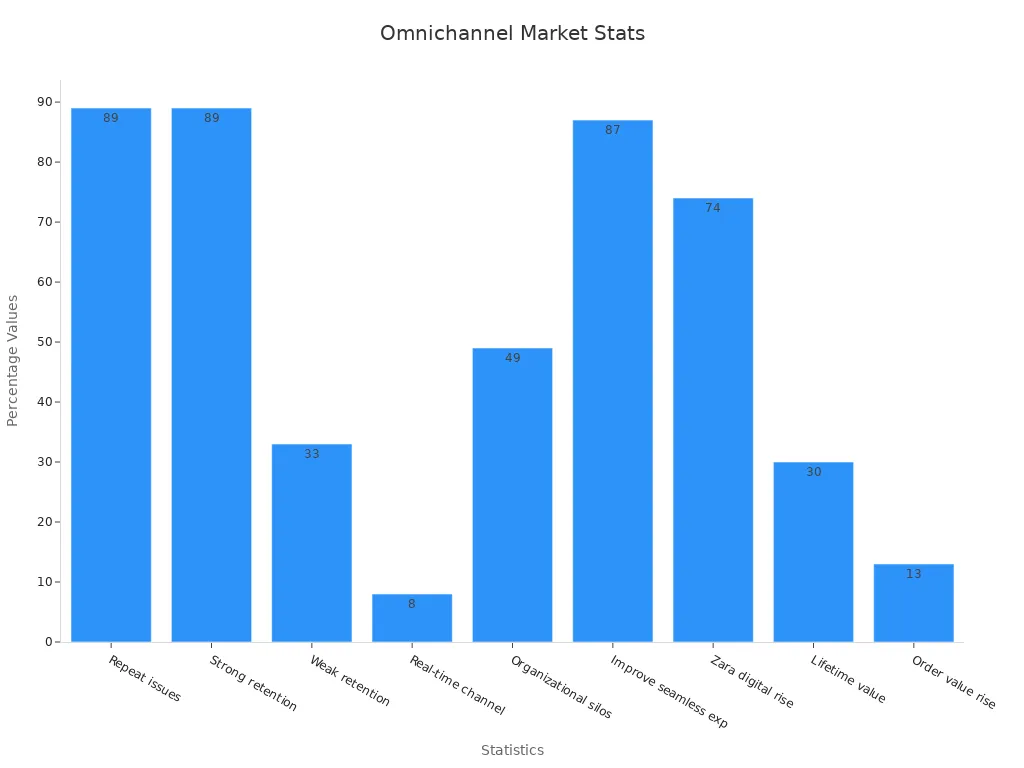
Sobot’s Omnichannel Solution exemplifies seamless integration by unifying customer interactions across platforms like email, social media, and voice. This ensures that your experience remains consistent and efficient, no matter how you choose to engage.
Examples of successful omnichannel strategies
Several companies have demonstrated the power of a well-executed omnichannel strategy. For instance:
- Costco Wholesale emphasizes the importance of relevant omnichannel experiences to maintain operational success.
- Kroger Co. has built its value creation model around its omnichannel retail business.
- Walmart Inc. has identified omnichannel execution as critical to its market position and financial performance.
A compelling example comes from Opay, a financial services platform. By implementing Sobot’s Omnichannel Solution, Opay streamlined customer interactions across social media, email, and voice channels. This integration led to a 90% customer satisfaction rate, a 20% reduction in costs, and a 17% increase in conversion rates. Such results showcase how a robust omnichannel strategy can transform customer experiences and drive business growth.
In today’s competitive landscape, adopting an omnichannel approach is no longer optional. It’s a necessity to meet evolving customer expectations and stay ahead in the market.
Hyper-Personalization: The future of customer experience trends
Leveraging AI and data for hyper-personalized interactions
Hyper-personalization has become a cornerstone of modern omnichannel strategies, enabling businesses to tailor interactions based on individual preferences. By leveraging advancements in AI and data analytics, companies can deliver experiences that feel uniquely crafted for you. For instance, machine learning analyzes your past behaviors to predict preferences, while big data analytics processes vast amounts of information to refine recommendations. Predictive analytics takes this further by forecasting your needs, allowing businesses to offer proactive solutions. Emotional Intelligence AI (EQ AI) even evaluates your mood to adjust interactions in real time.
| Advancement Type | Description |
|---|---|
| Machine Learning | Analyzes customer data to predict preferences and improve recommendation systems over time. |
| Big Data Analytics | Processes extensive consumer data to understand behaviors and enhance targeted recommendations. |
| Predictive Analytics | Forecasts customer demand by analyzing past behaviors, allowing for proactive and relevant offers. |
| Emotional Intelligence AI (EQ AI) | Evaluates emotional responses to tailor recommendations and interactions based on user mood. |
These technologies ensure your journey across omnichannel experiences feels seamless and personalized, enhancing satisfaction and loyalty.
Real-world examples of hyper-personalization in action
Amazon exemplifies the power of hyper-personalization. Its recommendation algorithm uses your browsing and purchase history to suggest products, resulting in higher conversion rates and repeat visits. Similarly, the beauty industry has embraced hyper-personalization by offering virtual consultations and customized product recommendations. These tailored experiences meet your growing expectations for personalization, making your shopping journey more engaging.
Sobot’s omnichannel solutions also demonstrate hyper-personalization in action. By integrating AI-driven tools, Sobot enables businesses to provide personalized experiences across channels like email, social media, and voice. This approach ensures that every interaction feels relevant and meaningful, whether you’re resolving an issue or exploring new products.
Benefits for businesses and consumers
Hyper-personalization offers significant benefits for both businesses and consumers. For businesses, it drives customer loyalty, increases average order value, and boosts satisfaction ratings. For example:
- Amazon’s personalized suggestions enhance user experience, leading to higher revenue and retention rates.
- Targeted promotions improve engagement and encourage repeat purchases.
For you as a consumer, hyper-personalization simplifies your journey. You receive relevant offers, faster resolutions, and a more enjoyable experience. Industries like retail, healthcare, and banking are increasingly adopting this trend, proving its value across diverse sectors.
As hyper-personalization continues to evolve, it will redefine how you interact with brands, making every touchpoint in your omnichannel journey more meaningful.
AI and Automation: Transforming omnichannel experiences

Conversational AI and its impact on customer service
Conversational AI has revolutionized how businesses interact with you. It uses technologies like natural language processing (NLP) and machine learning to create human-like interactions. This innovation allows businesses to provide immediate assistance, ensuring your needs are met without delays. For example, AI-powered chatbots can answer routine questions, guide you through processes, or even help you make purchases—all in real time.
The benefits of conversational AI extend beyond speed. It enhances customer engagement by offering personalized responses based on your preferences. Companies like Netflix and Sephora have successfully implemented conversational AI to recommend content or products tailored to your interests. This approach not only improves your experience but also builds loyalty by making every interaction meaningful.
Statistics further validate the impact of conversational AI. For instance:
| Statistic | Value | Description |
|---|---|---|
| 97% | Executives acknowledging positive impact on user contentment | Highlights how conversational AI boosts satisfaction. |
| $11 billion | Potential cost reduction in client service | Demonstrates the economic benefits of AI adoption. |
| 19% | Expected yearly growth of conversational AI market | Reflects the increasing importance of this technology. |
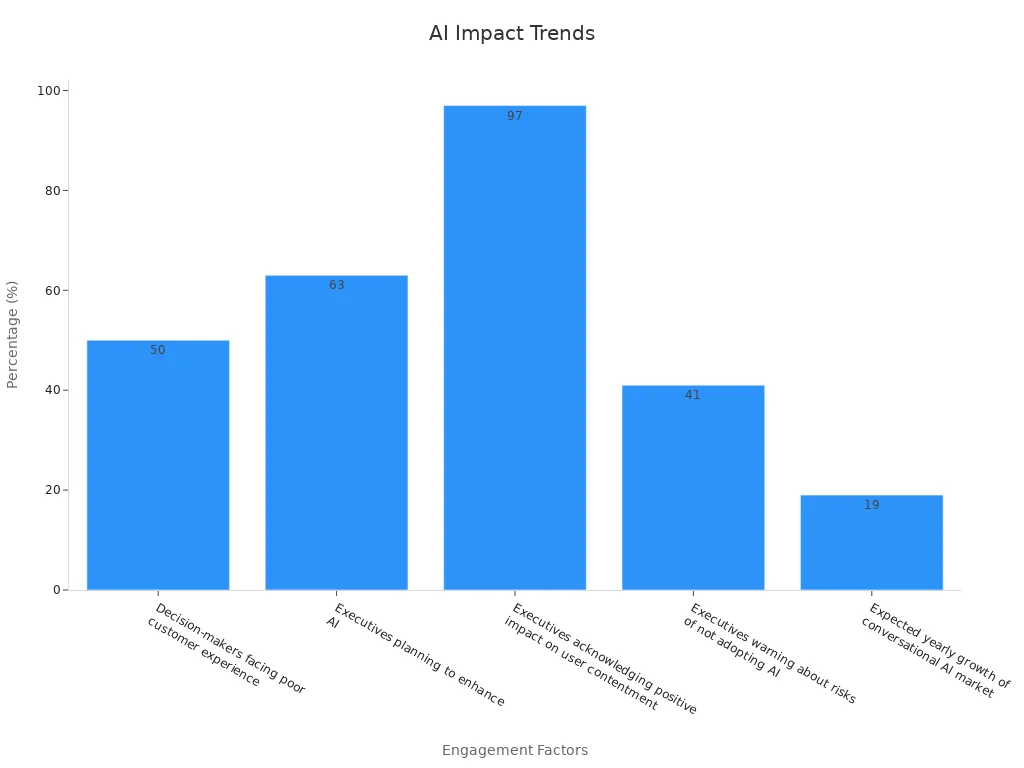
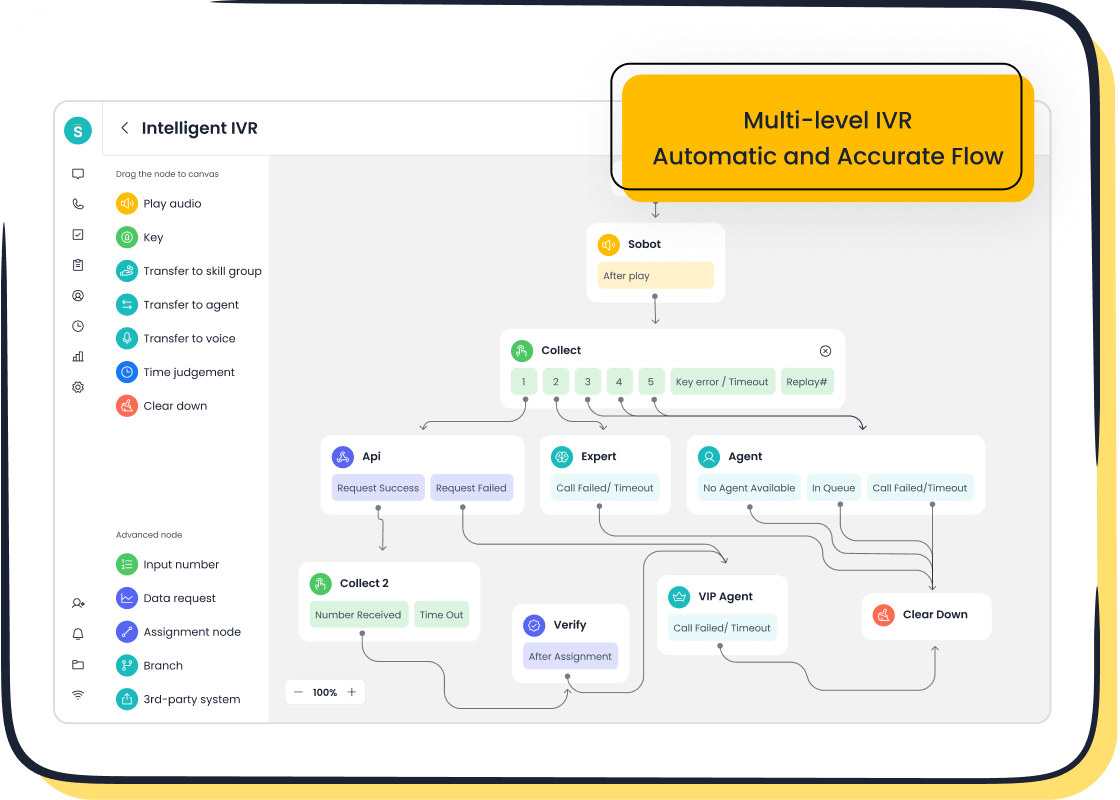
Sobot’s AI-powered Voice/Call Center exemplifies the power of conversational AI. Its intelligent voicebots handle high-volume queries efficiently, ensuring you receive quick and accurate resolutions. This technology reduces wait times and enhances your overall digital customer experience.
Predictive analytics for proactive customer engagement
Predictive analytics takes customer service to the next level by anticipating your needs before you even express them. By analyzing past behaviors and patterns, businesses can forecast potential issues and address them proactively. For example, e-commerce platforms use predictive analytics to recommend products based on your browsing history, making your shopping experience more personalized.
This approach significantly improves operational efficiency and customer satisfaction. Companies using predictive analytics report a 20-30% boost in efficiency and a 10-15% increase in satisfaction scores. Additionally, 87% of customers prefer proactive engagement, which strengthens their trust in the brand. Imagine receiving a notification about a product issue before it affects you—that’s the power of predictive analytics.
Sobot’s solutions integrate predictive analytics to enhance your digital customer experience. By identifying patterns in your interactions, Sobot enables businesses to offer timely and relevant solutions. This not only improves your satisfaction but also reduces unnecessary calls, saving time for both you and the support team.
Sobot's Voice/Call Center: Enhancing customer interactions with AI
Sobot’s Voice/Call Center combines AI and automation to deliver exceptional omnichannel experiences. Its intelligent IVR system ensures your calls are routed to the right agent or department, reducing wait times. The platform’s AI-powered voicebots handle routine inquiries, allowing agents to focus on complex issues. This creates a seamless and efficient interaction for you.
Key features of Sobot’s Voice/Call Center include:
- Smart Call Routing: Automatically directs your call to the most suitable agent.
- AI-powered Voicebot: Provides instant resolutions for common queries.
- Unified Workspace: Offers agents a comprehensive view of your history, ensuring personalized service.
These features translate into measurable benefits. For instance, AI-powered voicebots improve query resolution rates by 20%, while real-time analytics enhance agent performance by up to 25%. The platform also reduces average handling time, ensuring your issues are resolved quickly and efficiently.
By integrating advanced AI technologies, Sobot’s Voice/Call Center not only enhances customer engagement but also sets a new standard for digital customer experience. Whether you’re seeking support or exploring new services, Sobot ensures every interaction is smooth and satisfying.
Immersive Experiences: Redefining customer engagement

The rise of AR/VR in omnichannel strategies
Augmented reality (AR) and virtual reality (VR) are transforming how you interact with brands. These technologies create immersive experiences that blend the digital and physical worlds, making your journey more engaging. Recent studies show that AR and VR adoption is growing rapidly, with the market expected to expand at a compound annual growth rate of 34.2%. This growth highlights the increasing importance of these tools in shaping customer engagement.
AR features, such as virtual try-ons, make shopping more interactive. For example, you can see how a piece of furniture fits in your room or how a pair of glasses looks on your face before making a purchase. These experiences are 200% more engaging than traditional methods, encouraging you to explore products further. As AR and VR become more mainstream, they will play a vital role in omnichannel strategies, ensuring that your interactions feel seamless and innovative.
Experiential marketing and its role in customer loyalty
Experiential marketing focuses on creating memorable interactions that leave a lasting impression. Unlike traditional ads, which you might forget, experiential campaigns immerse you in the brand’s story. This approach not only attracts your attention but also builds a deeper emotional connection, encouraging you to return.
For instance, brands that combine online and in-store experiences gain a competitive edge. They use data to understand your behavior and create personalized interactions. This strategy enhances your satisfaction and loyalty while optimizing their operations. Experiential marketing ensures that every touchpoint in an omnichannel journey feels meaningful, making you more likely to stay loyal to the brand.
Case studies of immersive customer experiences
Many companies have successfully used immersive experiences to redefine customer engagement. For example, IKEA’s AR app allows you to visualize furniture in your home before buying it. This feature simplifies your decision-making process and enhances your shopping experience. Similarly, beauty brands like Sephora offer virtual try-ons, enabling you to test products without visiting a store.
Sobot’s omnichannel solutions also integrate immersive technologies to improve your experience. By unifying channels like social media, email, and voice, Sobot ensures that your interactions remain consistent and engaging. These strategies demonstrate how immersive experiences can transform customer journeys, making them more interactive and satisfying.
Immersive experiences are no longer optional in today’s competitive market. They are essential for creating meaningful connections and ensuring that your omnichannel journey feels seamless and memorable.
Omnichannel Harmony: Achieving seamless customer interactions
Key technologies driving omnichannel harmony
Achieving seamless omnichannel interactions requires leveraging advanced technologies that unify customer touchpoints. Businesses today rely on tools that enhance engagement, streamline operations, and deliver personalized experiences.
| Key Components | Description |
|---|---|
| Advanced technology | Cutting-edge platforms improve customer engagement and operational efficiency. |
| Robust data and analytics | Strong data management systems provide actionable insights for better decision-making. |
| Skilled customer-facing teams | Well-trained teams ensure effective communication and problem resolution. |
| Alignment across functions | Cohesive collaboration between marketing, sales, and support teams enhances customer journeys. |
Artificial intelligence plays a pivotal role in driving omnichannel harmony. AI-powered tools analyze customer data to understand preferences and intent, enabling hyper-personalized shopping experiences. Retailers use these innovations to recommend products and deliver targeted promotions across multiple channels, ensuring every interaction feels relevant to you.
Sobot's Omnichannel Solution: Unifying customer touchpoints
Sobot’s Omnichannel Solution exemplifies how technology can unify customer interactions across platforms. By integrating social media, email, voice, and chat into a single workspace, Sobot eliminates the need for fragmented systems. This approach ensures that your experience remains consistent, whether you’re browsing online or seeking support.
| Metric | Value |
|---|---|
| Percentage of business from upgrades | 70% |
| Reduction in waiting times | 35% |
| Customer satisfaction rate | 95% |
Over 10,000 brands have improved their Net Promoter Score (NPS) using Sobot’s solutions. For example, fresh food e-commerce companies resolved disjointed system issues by adopting Sobot’s platform. These results highlight how omnichannel integration enhances efficiency and satisfaction, making your interactions smoother and more enjoyable.
Overcoming challenges in omnichannel integration
Implementing omnichannel strategies comes with challenges, but addressing them effectively ensures success. Businesses often struggle with technology integration, inventory management, and meeting customer expectations.
| Challenge | Description |
|---|---|
| Technology Integration | Combining platforms like e-commerce, CRM, and POS systems for real-time data access. |
| Building the Customer Experience | Delivering consistent and personalized journeys across all channels. |
| Inventory Management | Synchronizing inventory to avoid discrepancies across platforms. |
| Data Management & Analysis | Collating and analyzing customer data for actionable insights. |
| Supply Chain Complexities | Coordinating logistics and inventory across multiple channels. |
| Meeting Customer Expectations | Ensuring seamless and personalized shopping experiences. |
| Internal Training | Equipping employees with skills to manage omnichannel operations effectively. |
Sobot’s solutions address these challenges by offering unified workspaces, AI-driven analytics, and proactive insights. These tools simplify operations, reduce inefficiencies, and ensure your experience remains seamless across all touchpoints.
Proactive Engagement: Anticipating customer needs
The importance of predictive analytics in customer service
Predictive analytics has become a cornerstone of proactive customer engagement. By analyzing historical and current data, businesses can forecast your needs and address them before you even ask. This approach uses statistical algorithms and machine learning to identify patterns in behavior and market trends. For example, e-commerce platforms predict your preferences based on browsing history, offering tailored recommendations that simplify your shopping experience.
The growing importance of predictive analytics is evident in its market trends. Revenue from predictive analytics is expected to rise from $14.71 billion in 2023 to $67.66 billion by 2030. Companies investing in AI-powered tools, including predictive analytics, report up to a 15% increase in revenue and a 20% uplift in sales ROI. These figures highlight how anticipating your needs can transform customer service and drive business success.
Strategies for proactive engagement across channels
Proactive engagement involves reaching out to you with timely solutions and relevant information across multiple channels. Businesses use strategies like sending notifications, engaging through social media, and offering personalized communication to enhance your experience. For example, receiving a reminder about an upcoming sale or a follow-up message after a purchase builds trust and keeps you connected to the brand.
Effective proactive engagement relies on several best practices:
- Sending timely and relevant notifications improves your experience and fosters loyalty.
- Utilizing web, mobile, and social platforms ensures communication aligns with your preferences.
- Training customer service teams equips them to anticipate your needs and deliver proactive solutions.
- Continuous learning helps maintain high standards of service across all channels.
These strategies ensure your customer journey feels seamless and personalized, making every interaction meaningful.
Examples of brands excelling in proactive customer engagement
Brands that excel in proactive engagement focus on anticipating your needs and creating memorable experiences. For instance:
- Personalized communication ensures you receive relevant updates and offers.
- Timely follow-ups after purchases or inquiries demonstrate a commitment to your satisfaction.
- Understanding your preferences allows brands to tailor interactions, fostering lasting relationships.
Sobot’s omnichannel solutions exemplify proactive engagement by unifying channels like email, social media, and voice. This integration enables businesses to anticipate your needs and provide timely support, ensuring your customer journey remains smooth and satisfying.
Proactive engagement is more than a trend; it’s a strategy that builds trust and strengthens relationships. By anticipating your needs, businesses create experiences that keep you coming back.
Loyalty Programs and Emotional Intelligence in omnichannel strategies
The evolution of loyalty programs in the digital age
Loyalty programs have transformed significantly in the digital era, moving beyond traditional point systems to more integrated and engaging models. Today, businesses use app-based programs that connect seamlessly with e-commerce platforms and digital payment systems. This shift eliminates the need for physical cards, making it easier for you to track rewards and redeem benefits.
Modern loyalty programs focus on personalization to enhance your experience. AI enables businesses to tailor rewards based on your preferences, ensuring you feel valued. Gamification has also become a popular trend, adding an element of fun to your interactions. For example, earning badges or unlocking levels can make your journey more enjoyable. Additionally, many brands now align loyalty programs with sustainability and unique experiences, reflecting your values and fostering emotional connections.
Future technologies like blockchain, augmented reality (AR), and virtual reality (VR) are expected to further revolutionize loyalty programs. These innovations will create immersive and secure experiences, ensuring that your engagement feels both exciting and meaningful.
Using AI for emotional intelligence in customer interactions
AI has become a powerful tool for enhancing emotional intelligence in customer interactions. By analyzing vocal tones, facial expressions, and historical data, AI can assess your emotions in real time. This allows businesses to respond empathetically, creating a more human-like experience.
For instance, AI tools can predict your emotional responses and adjust their communication style accordingly. If you’re frustrated, the system might offer a calming tone and quick solutions. Continuous learning systems further improve these interactions by refining emotional assessments over time. This approach has led to a 20% increase in customer satisfaction and a 15% boost in retention rates. Emotion-driven strategies also reduce churn by addressing negative feelings proactively, ensuring you remain loyal to the brand.
Sobot’s omnichannel solutions integrate AI to deliver emotion-driven support across platforms like email, social media, and voice. These tools ensure that every interaction feels personalized and empathetic, enhancing your overall experience.
Building emotional connections to enhance customer loyalty
Emotional connections play a crucial role in fostering loyalty. People often make decisions based on feelings rather than logic, which is why brands that appeal to your emotions tend to build stronger relationships. Offering exceptional service, providing unexpected surprises, and creating memorable moments are effective ways to connect with you on a deeper level.
Consistency and follow-through are also essential. When a brand delivers on its promises, it builds trust, making you more likely to stay loyal. Emotional branding further strengthens this bond by making you feel understood and valued. For example, campaigns that focus on shared values or community involvement resonate with you, creating a sense of belonging.
Sobot’s omnichannel solutions help businesses build these emotional connections by unifying customer interactions and ensuring consistent, personalized service. This approach not only enhances your satisfaction but also encourages long-term loyalty.
The omnichannel customer experience in 2025 revolves around consistency, personalization, and innovation. Businesses must adapt to emerging trends like AI, hyper-personalization, and immersive technologies to meet evolving expectations. For instance, 71% of consumers value consistent interactions across channels, yet only 29% experience it. Satisfied customers are 3.6 times more likely to buy additional products, and those engaging in omnichannel experiences have a 1.6 times higher lifetime value.
| Evidence | Description |
|---|---|
| 71% of consumers | Feel that consistency should be maintained across channels. |
| 29% of consumers | Actually experience consistency in their interactions. |
| 3.6x more likely | Satisfied customers are to buy additional products and services. |
| 1.6x higher | Lifetime value of customers who engage in omnichannel experiences. |
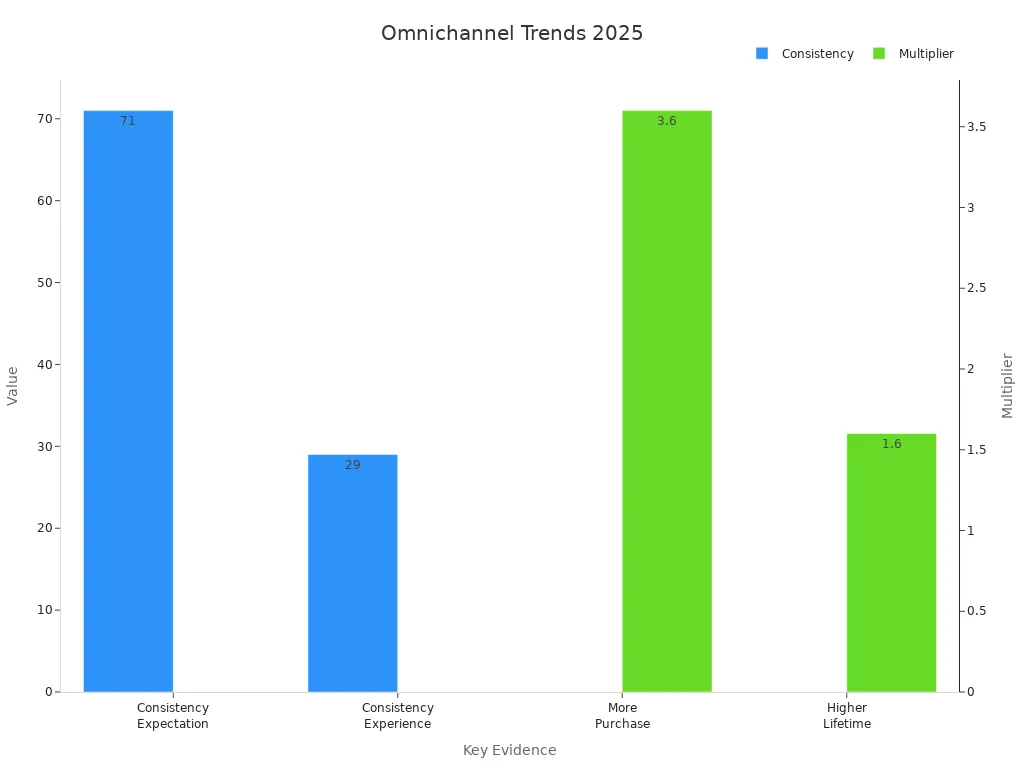
To stay ahead, prioritize AI-driven tools for predictive analytics, invest in immersive technologies like AR/VR, and focus on hyper-personalized ecommerce experiences. Sobot’s Voice/Call Center and Omnichannel Solution unify customer touchpoints, ensuring seamless shopping journeys. These tools help businesses reduce inefficiencies, improve satisfaction, and build loyalty.
FAQ
What is the main benefit of adopting an omnichannel strategy for your business?
An omnichannel strategy ensures a seamless experience across all touchpoints. It improves cx by unifying interactions, increasing customer satisfaction, and boosting loyalty. Businesses also benefit from streamlined omnichannel operations, which enhance efficiency and reduce costs.
How does AI improve cx in omnichannel customer service?
AI enhances cx by personalizing interactions, predicting customer needs, and automating repetitive tasks. It ensures faster resolutions and more meaningful engagements, making your experience smoother and more satisfying.
Why is hyper-personalization important in cx?
Hyper-personalization tailors experiences to your preferences, making interactions more relevant. It uses data and AI to predict your needs, ensuring you feel valued. This approach strengthens loyalty and improves overall cx.
How do immersive technologies like AR/VR impact cx?
AR/VR creates engaging and interactive experiences. You can visualize products or try them virtually, enhancing your decision-making process. These technologies make your journey more enjoyable and memorable, redefining cx.
What role does predictive analytics play in proactive customer engagement?
Predictive analytics anticipates your needs by analyzing past behaviors. It helps businesses address issues before they arise, ensuring a proactive approach to cx. This builds trust and improves your overall experience.
See Also
A Comprehensive Guide to Omnichannel Contact Center Strategies
Essential Insights on Omnichannel Call Center Tools
Discovering Leading Cloud Contact Centers for 2025
